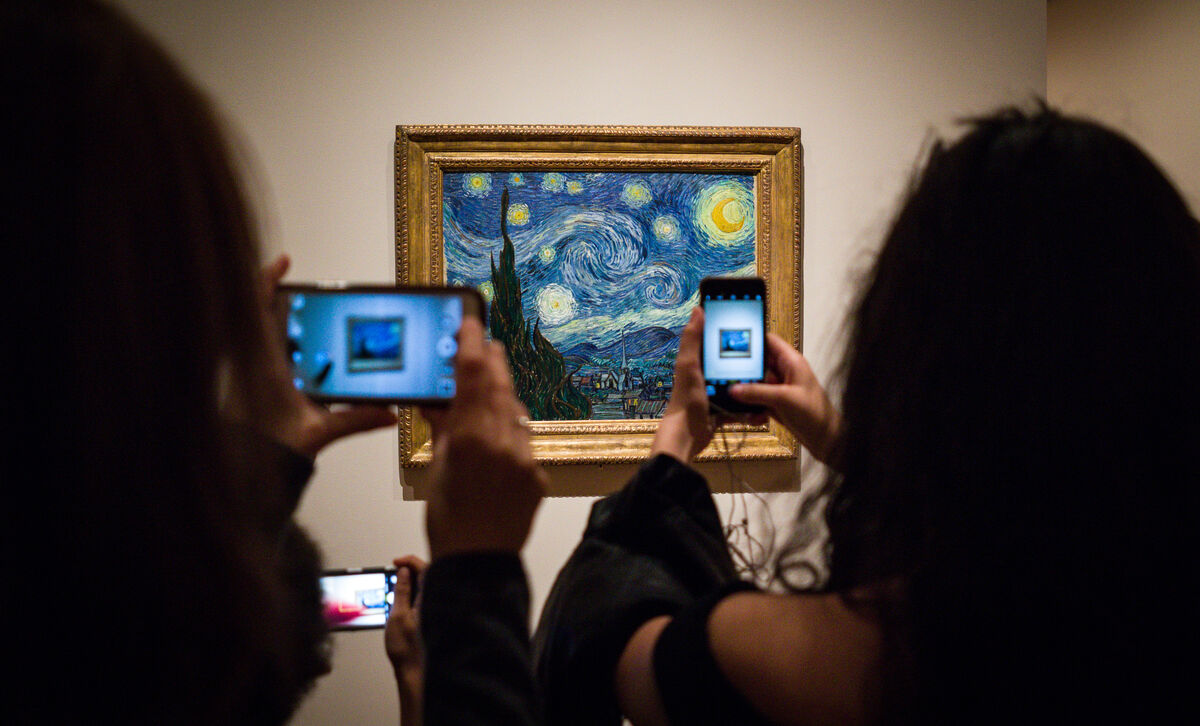There’s no point in debating whether cell phones are a wonder or a necessary evil; they’re just a fact of life that isn’t going to change. But I will say I admire those who manage to walk the line between taking full advantage of their mobile’s assets while still maintaining the upper hand over it. And I’m even more intrigued when someone figures out how to use the pervasiveness of our phones, and our behavior with them, to artistic benefit.
No question, I count on my phone’s camera when visiting museums and galleries. With the sound and flash off, I can unobtrusively snap a quick photo of a piece and its accompanying ID/info card, allowing me to revisit the work and read more about it later (and of course to have shots to include in this blog).

Photo by Phil Roeder, via Flickr, via artsy.net
But there is definitely a dark side to allowing cell phones and cameras in public art spaces. As you have no doubt experienced, it’s no joy to navigate an obstacle course of selfie-takers, or to thread one’s way through a sea of upraised, photo-taking arms, hoping to enjoy an unobstructed view of an artwork you may well have traveled some distance to experience in person.

iPainting (186230889), Robert Buck ©2016 Alert paint and acrylic on canvas This is the painting as is, the image below includes the flash from my camera.
It’s the very clever artist who acknowledges our penchant for constant documentation, while simultaneously manipulating that tendency in such a way that it enhances not just his art, but the experience of viewing of it. Robert Buck’s iPainting and iPrints at the Helen Day Art Center’s current exhibition Love Letters, are a stunning example. Buck pairs his work with viewer-provided technology (camera flash), intentionally weaving both the art and the picture-snapping viewer together symbiotically. In fact, it is only when the two are integrated that he considers the work fully realized.

iPainting (186230889), Robert Buck ©2016 Alert paint and acrylic on canvas As noted on the gallery card beside the painting: “Buck’s iPaintings are made using a combination of acrylic and Alert paint, an oil-based industrial coating, which, due to an additive of minuscule glass beads, is highly reflective. Consequently, when the painting is illuminated by the flash of a camera, the Alert paint fluoresces and a fallow image appears…the completion of the piece comes in the moment the viewer is photographed in front of the work, thus haloed by the reflective light, becoming universally connected and filled with light.”
Not the greatest fan of cell phones and their interruptions, I find the idea of Buck’s work brilliant. Is it a gimmick? Maybe. But I am reminded of visiting the Uffizi Gallery in 2018. Anxious to get close enough to see and follow Botticelli’s brushstrokes in his monumental Primavera and Birth of Venus, I hung back while group after group took pictures of themselves with the work as their backdrop. I soon realized that it wasn’t so much the work itself that fascinated them, it was the idea of a picture of themselves next to it. With no break in sight, I finally decided to edge my way to the front so I wouldn’t miss an opportunity to see Botticelli’s genius up close. And truthfully, I don’t think my presence made the slightest difference to those whose attention was primarily trained on images of themselves. Imagine, however, if those paintings had somehow been affected as they snapped their pictures. Would such a effect have incurred a fuller sort of engagement? And how would that affect the experience of other nearby viewers?
Buck’s work makes me wonder how other artists will circumvent and/or incorporate technology in such a way that it will no longer be regarded as intrusive in an environment often reserved for meditative contemplation. Never discount the ability of the artistic mind to finding a way to mold reality, for better or for worse, to a higher – or should I say different – purpose.
See more of Robert Buck’s iPaintings.
❖
Food for thought: This article considers how cell phones impact cognition and, more specifically, whether and how they affect one’s appreciation of art. It has some surprising revelations.





















